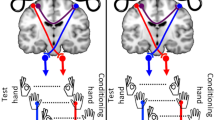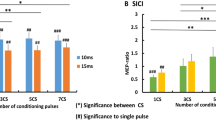Abstract
We tested the hypothesis that transcranial magnetic stimulation (TMS), in addition to its inhibitory action on the corticospinal output, can also exert some inhibitory effect on the transcallosal system connecting the two motor cortices. In seven normal subjects, instructed to keep their right opponens pollicis (OP) muscle fully relaxed and their left OP muscle voluntarily contracted, we used a paired-pulse TMS protocol, to stimulate the left motor cortex. We evaluated the effect of low-intensity conditioning stimulation on the ipsilateral silent period (iSP) elicited by the subsequent test stimulus. Compelling evidence exists to support that this iSP is mediated by the activation of transcallosal motor fibres. Simultaneously, the inhibition of the motor evoked potential (MEP) in the right OP muscle was also investigated. At the interstimulus interval (ISI) of 3 ms, the iSP was significantly (P<0.0001, repeated-measures ANOVA) suppressed by conditioning intensities ranging from 1.2 to 0.6 of MEP threshold. The assessment of the time-course showed that iSP inhibition was present in all the tested subjects only at ISIs of 2 and 3 ms (for each subject P<0.05, repeated-measures ANOVA). Several findings suggest that the suppression of iSP is brought about by the activation of inhibitory mechanisms operating in the stimulated (left) motor cortex. We propose that the assessment of iSP suppression could be a method to study the excitability of intracortical inhibitory circuits in the affected hemisphere of patients with unilateral damage of the corticospinal tract.





Similar content being viewed by others
References
Abbruzzese G, Trompetto C (2002) Clinical and research methods for evaluating cortical excitability. J Clin Neurophysiol 19:307–321
Amaral DG (2000) The anatomical organization of the central nervous system. In: Kandel ER, Schwartz JH, Jessell TM (eds) Principles of neural science. McGraw-Hill, New York, pp 317–336
Asanuma H, Okuda O (1962) Effects of transcallosal volleys on pyramidal tract cell activity of cat. J Neurophysiol 25:198–208
Berlucchi G (1990) Commisurotomy studies in animals. In: Boller F, Grafman J (eds) Handbook of neuropsychology. Elsevier, Amsterdam, pp 9–47
Boroojerdi B, Diefenbach K, Ferbert A (1996) Transcallosal inhibition in cortical and subcortical cerebral vascular lesions. J Neurol Sci 144:160–170
Brodal A (1973) Self-observation and neuro-anatomical considerations after a stroke. Brain 96:675–694
Catsman-Berrevoetes CE, Lemon RN, Vanburgh CA, Bentivoglio M, Kuypers HGJM (1980) Absence of callosal collaterals derived from rat cortico-spinal neurones. A study using fluorescent retrograde tracing and electrophysiological techniques. Exp Brain Res 39:433–440
Chen R, Corwell B, Yaseen Z, Hallett, M, Cohen LG (1998) Mechanisms of cortical reorganization in lower-limb amputees. J Neurosci 18:3443–3450
Daskalakis ZJ, Christensen BK, Fitzgerald PB, Roshan L, Chen R (2002) The mechanisms of interhemispheric inhibition in the human motor cortex. J Physiol 15:317–326
Davey NJ, Romaiguere P, Maskill DW, Ellaway PH (1994) Suppression of voluntary motor activity revealed using transcranial magnetic stimulation of the motor cortex in man. J Physiol 477:223–235
Day BL, Dressler D, Maertens de Noordhout A, Marsden CD, Nakashima K, Rothwell JC, Thompson PD (1989) Electric and magnetic stimulation of human motor cortex: surface EMG and single motor unit responses. J Physiol 412:449–473
Di Lazzaro V, Restuccia D, Oliviero A, Profice P, Ferrara L, Insola A, Mazzone P, Tonali P, Rothwell JC (1998) Magnetic transcranial stimulation at intensities below active motor threshold activates intracortical inhibitory circuits. Exp Brain Res 119:265–268
Ferbert A, Priori A, Rothwell JC, Day BL, Colebatch JG, Marsden CD (1992) Interhemispheric inhibition of the human motor cortex. J Physiol 453:525–546
Fuhr P, Agostino R, Hallett M (1991) Spinal motor neuron excitability during the silent period after cortical stimulation. Electroencephalogr Clin Neurophysiol 81:257–262
Hanajima R, Ugawa Y, Machii K, Mochizuki H, Terao Y, Enomoto H, Furubayashi T, Shiio Y, Uesugi H, Kanazawa I (2001) Interhemispheric facilitation of the hand motor area in humans. J Physiol 531:849–859
Hess CW, Mills KR, Murray NM (1987) Responses in small hand muscles from magnetic stimulation of the human brain. J Physiol 388:397–419
Kimura F, Baughman RW (1997) GABAergic transcallosal neurons in developing rat neocortex. Eur J Neurosci 9:1137-1143
Kujirai T, Caramia MD, Rothwell JC, Day BL, Thompson PD, Ferbert A, Wroe S, Asselman P, Marsden CD (1993) Corticocortical inhibition in human motor cortex. J Physiol 471:501–519
Liepert J, Classen J, Cohen LG, Hallett M (1998) Task-dependent changes of intracortical inhibition. Exp Brain Res 118:421–426
Liepert J, Storch P, Fritsch A, Weiller C (2000) Motor cortex disinhibition in acute stroke. Clin Neurophysiol 111:671–676
Meyer BU, Roricht S, Grafin von Einsiedel H, Kruggel F, Weindl A (1995) Inhibitory and excitatory interhemispheric transfers between motor cortical areas in normal humans and patients with abnormalities of the corpus callosum. Brain 118:429–440
Meyer BU, Kuehn A, Roerich S (1996) Influence of the direction of induced currents on callosaly and corticospinally mediated electromyographic responses following magnetic motor cortex stimulation in man. J Physiol 497:34P
Meyer BU, Roricht S, Woiciechowsky C (1998) Topography of fibers in the human corpus callosum mediating interhemispheric inhibition between the motor cortices. Ann Neurol 43:360–369
Ridding MC, Sheean G, Rothwell JC, Inzelberg R, Kujirai T (1995) Changes in the balance between motor cortical excitation and inhibition in focal, task specific dystonia. J Neurol Neurosurg Psychiatry 59:493–498
Rothwell JC (1991) Physiological studies of electric and magnetic stimulation of the human brain. Electroencephalogr Clin Neurophysiol [Suppl] 43:29–35
Rothwell JC, Colebatch J, Britton TC, Priori A, Thompson PD, Day BL, Marsden CD (1991) Physiological studies in a patient with mirror movements and agenesis of the corpus callosum. J Physiol 438:34P
Salerno A, Georgesco M (1996) Interhemispheric facilitation and inhibition studied in man with double magnetic stimulation. Electroencephalogr Clin Neurophysiol 101:395–403
Trompetto C, Assini A, Buccolieri A, Marchese R, Abbruzzese G (1999) Intracortical inhibition after paired transcranial magnetic stimulation depends on the current flow direction. Clin Neurophysiol 110:1106–1110
Trompetto C, Buccolieri A, Marchese R, Marinelli L, Michelozzi G, Abbruzzese G (2003) Impairment of transcallosal inhibition in patients with corticobasal degeneration. Clin Neurophysiol 114:2181–2187
Ugawa Y, Hanajima R, Kanazawa I (1993) Interhemispheric facilitation of the hand area of the human motor cortex. Neurosci Lett 160:153–155
Valls-Solè J, Pascual-Leone A, Wassermann EM, Hallett M (1992) Human motor evoked responses to paired transcranial magnetic stimuli. Electroencephalogr Clin Neurophysiol 85:355–364
Wassermann EM, Fuhr P, Cohen LG, Hallett M (1991) Effects of transcranial magnetic stimulation on ipsilateral muscles. Neurology 41:1795–1799
Wassermann EM (2002) Variation in the response to transcranial magnetic brain stimulation in the general population. Clin Neurophysiol 113:1165–1171
Author information
Authors and Affiliations
Corresponding author
Rights and permissions
About this article
Cite this article
Trompetto, C., Bove, M., Marinelli, L. et al. Suppression of the transcallosal motor output: a transcranial magnetic stimulation study in healthy subjects. Exp Brain Res 158, 133–140 (2004). https://doi.org/10.1007/s00221-004-1881-6
Received:
Accepted:
Published:
Issue Date:
DOI: https://doi.org/10.1007/s00221-004-1881-6




